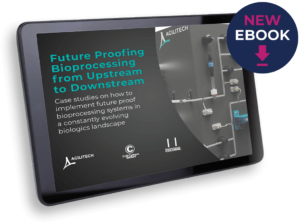
Staying Ahead of a Constantly Evolving Biologics Industry
 This article was originally published in the eBook
This article was originally published in the eBook“ Future proofing Bioprocessing from Upstream to Downstream”.
You can download all the articles in the series, by downloading the eBook.
The biopharmaceutical industry has been growing and expanding since the 1980’s. Early biopharmaceutical manufacturing using CHO cells looked much different than biologic production today. Processes were seriously inefficient by today’s standards with much of the work being done using manual and open processes. In contrast, current commercial biologics manufacturing utilizes specialized bioreactors, technologically advanced purification systems, continuous monitoring and automation. These and other bioprocess improvements have enabled the most efficient and productive manufacturing to date and have resulted in some of the most advanced lifesaving therapeutics ever conceived.
While significant advancements have been made in biomanufacturing, the industry continues to evolve to meet new demands. Pressures, such as the advent of biosimilars, a focus on reducing drug costs, and responding to a worldwide pandemic have forced the industry to adapt and respond with new technologies. However, with new advancements often comes new challenges. In this article, we look at some of the current trends and challenges facing the biologics industry today along with innovative approaches to enable companies to stay ahead of the evolution.

Industry Trends
Single-use Technologies
One of the most significant advancements in biologics manufacturing has been the invention and adoption of single-use technologies. Single-use systems continue to be adopted at a rapid rate; as of 2018, they accounted for about 85% of preclinical and clinical biomanufacturing and are increasingly being incorporated into commercial manufacturing.¹ Experts foresee this trend continuing with single-use bioprocessing systems continuing to replace commercial-scale stainless steel-based manufacturing, both at commercial manufacturing and clinical scales.²
Single-use technologies owe this increased adoption to several key advantages including reduced risk of contamination, increased efficiency, reduced personnel requirements, less validation time, decreased cost for cleaning and sterilization, and shorter batch changeover time. However, challenges also exist including supply chain shortages, lack of flexibility within a platform, lack of standardization of equipment and consumables, and control system incompatibility.
Shifting Demand for Manufacturing Capacity
Changes in product manufacturing demand also require adjustment to process and scale. As a result, biopharmaceutical companies are seeking manufacturing that is easily scalable. Single-use systems and scale-out approaches to manufacturing have enabled this movement. There is no doubt that these strategies will continue to be in high demand. The COVID-19 pandemic has been an excellent lesson as to the importance of being able to significantly increase manufacturing capacity rapidly. We are also moving toward new therapeutics that require smaller volumes, such as cell and gene therapies. Experts also predict, an “increase in the number of biopharmaceutical products marketed, with a focus on developing smaller markets, personalized products, and biosimilars.”²
Flexible Manufacturing Facilities
Spearheaded by recent developments in medical research, and in personalized medicine and gene therapy in particular, biotech facilities are shifting from high-volume productions to multi-batch production of smaller-scale product.³ Where stainless steel is conducive to large-volume production, a desire for increased flexibility has created a demand for smaller, more agile processes enabled by single-use systems. The result has been fewer product-dedicated facilities2 and an increase in facilities that run smaller manufacturing lots with several different products.2
Adoption of New Enabling Technologies
Processes frequently change because of new enabling technologies. The advent of single-use systems, perfusion culture, as well as better analytical tools and sensors are just a sampling of the technologies that have changed bioprocessing over the past decade. This trend will most certainly continue with increased adoption of continuous processing, including upstream perfusion and continuous chromatography for downstream processing as technology and experience increase.²
Implementing these improvements is not often straightforward. Bioprocesses are not always built with the kind of flexibility that allows them to quickly adapt to improvements.³ Change can be diffcult and there is sometimes a perception that the cost and lost time associated with new workflows, qualification of new components, and technological investment may not be worth the effort. However, employing innovative technologies as well as the ability to evolve and do so quickly is key for speed to market, meeting quality attributes, and cost-effective manufacturing.
Increased Automation
Increased automation reduces the need for sampling by incorporating in-line monitoring, control, and data collection into the bioprocessing equipment to maintain closed and aseptic environments.² Yet, increased data collection necessitates a way to balance the need to improve processes through automation and integration, while also investing in human resources to properly analyze data and make sure the company stays compliant to industry audit regulations. Current lab systems often produce data output in non-user-friendly formats that are burdening scientists with data conversion or making them increasingly reliant on data analysts before they can do meaningful analysis. While automation software is designed to streamline processes, few have the robustness to support a complete lab bioprocess and its eventual scale-up at cGMP manufacturing levels.³
Novel Approaches to Meet Evolving Industry Demands
The best way to ensure efficient biomanufacturing is to future-proof bioprocesses with flexible systems that enable companies to respond to changing priorities, new opportunities, and increasing demands.
Leveraging Multiple Vendors to Reduce Supply Chain Constraints
The industry is currently experiencing significant equipment and raw material shortages, largely due to the impact of the COVID-19 pandemic, but also due to an increase in single-use product demand.³ However, some materials are prone to shortage, and were diffcult to source prior to the pandemic. There is a worldwide shortage of some of the key high-purity polymers causing increased lead times for certain consumables.4 In a recent survey conducted by BioPlan Associates, 75% of biopharma respondents and 70% of supplier respondents listed shortage of single-use systems and other supply issues as a top concern in bioprocessing post COVID-19.4
As a result, end users can face long delivery times sometimes up to fourteen months for certain consumables.5 Frequently vendors can deliver equipment within a few months, but without the consumables, the equipment is not usable. End users, particularly smaller companies, have also experienced slow response times for service request quotes for single-use systems due to required supplier support for COVID-19 vaccine and therapeutic production.
Furthermore, many equipment vendors have single source supply chains because of their proprietary solutions; this also impacts the ability to increase supply quickly, as does facility and workforce constraints.5
Supply challenges can be addressed in the near term by providing equipment designs that are less proprietary and more open or agnostic. This way multiple vendors can be leveraged to provide a solution, thus permitting quicker deliveries. Customers may want to carefully consider this before they get locked into a proprietary solution that creates a single source of supply, especially for consumables. Agilitech, a provider of single-use technologies, looks at multiple vendors to provide best-in-class components for specific applications. Not being tied to a specific component or vendor allows Agilitech to create solutions that are best in class and truly fit it for their customers’ unique processes. It also enables shorter delivery times for equipment and consumables.
Collaboration
A key tool for ensuring that a process is flexible and adaptable is through collaboration. There needs to be good communication between the biopharmaceutical companies, suppliers, and regulators to ensure that the industry can be nimble in responding to internal and external changes. A good collaboration can also create a process that exactly fits the purpose for which it was designed. For instance, Agilitech works with customers to co-design process-based solutions that meet their exact requirements. This front-end planning and collaborative design process is typically no more costly than other available products, while providing significant benefits to the overall workflow.
Another area where collaboration is key is in implementing increased automation. Agilitech leverages a strong engineering background to approach automation problem solving with customers from a process optimization perspective by looking at the whole as well as the parts. With broad automation experience on DeltaV™, Rockwell Automation®, and other leading platforms, Agilitech works with customers to understand their pain points and find a solution using the existing hardware and software components that they have. This helps to ensure ease of process transfer for a growing company and offers a flexible platform for customizability. Users can also make system modifications on their own if they have the resources to do so. Agilitech’s flexible approach to automation and bioprocess control also enables seamless integration of equipment from different manufacturers and helps to eliminate the islands of automation that are often found in biotech laboratories.
Fully Customizable Fit-for-purpose Solutions
One of the major challenges to flexibility in facilities and in the manufacturing process is technological incompatibility. While customizability of a platform process is the primary goal, the reality is that customizing an existing platform has limitations.
Market-leading suppliers offer a range of competitive single-use systems with some flexibility within their platform of products. However, full flexibility of these products is often limited: they are flexible in that they are single use, facilitating quick and sterile batch changes between production runs, but the instruments themselves are not always adaptive to unique process needs and typically do not integrate products and/or components outside of brand.
There is a need in the industry for more flexible solutions that can be tailored to specific bioprocessing needs, as well as solutions that can adapt and evolve as process requirements change. Agilitech offers a different approach to flexibility by providing systems that can be tailored to specific needs and integrate fit-for-purpose workflows.
Move to Brand-agnostic Systems
Brand-agnostic systems provide end users the freedom to work with the companies and products that best meet a workflow need. This approach can also help mitigate supply chain issues, as process equipment can have the flexibility to use components from different vendors and brands.
Agilitech provides brand-agnostic systems that can be reconfigured to use filters, sensors, and other components from virtually any manufacturer brand. For example, customers can use their preferred filter brand with their preferred sensors along with a custom-configured flow path. This enables them to fully customize their bioprocess while minimizing the equipment operation/maintenance learning curve and their spare parts inventory. This adaptability also means that users become co-designers of their equipment and that they can continue to evolve their instruments according to changing needs and evolving technology.
Agilitech is not limited to the same supply chain constraints that other vendors are; if there is an issue with delivery of a specific component, they can pivot to a different vendor with quicker delivery times without any effect on the design or the delivery of the system. This approach allows customers who have long-term relationships with specific vendors to leverage that relationship for better pricing as well as eliminating the need to maintain several different components in their onsite inventory.
For automation, it is critical to create solutions based on open architecture control systems. This means the systems are not proprietary and can be supported by the end user’s in-house automation team. This also provides customers the flexibility to go from a standalone control capability to a distributed control architecture in the future, which is important as a company grows and begins to scale up. It also enables the move from manual to fully automated control.
Future Proofing Process Design
Future proofing a manufacturing system ensures that it evolves with the industry. To do this successfully, it is important to understand the short- and long-term manufacturing goals, as well as current constraints. It is also key to reduce capital spending up front and allows companies to purchase only what they need at the time, but with the building blocks required to grow the system as the company grows.
Conclusion
Full flexibility requires equipment that is easily tailored to specific needs, reconfigurable, and able to evolve with the workflow to incorporate technological innovation and address changes in supply or demand. It also means having instruments and operating systems that are brand agnostic, which enables scientists and lab technicians to create fully customizable processes and operations that fit their production needs. This will allow scientists to not only design their “dream process,” but also frees them to forge partnerships with a variety of vendors and suppliers to optimize their engineering process, both effciently and cost-effectively.
It is important for today’s providers of single-use and other bioprocessing technologies and services to focus on understanding and accommodating unique customer needs to provide solutions that are truly fit-for-purpose with the flexibility required to adapt to future stresses or demands on the process.
In the following articles, we will look at specific solutions and case studies in upstream and downstream bioprocesses. We also present best practices for creating a holistic upstream and downstream process, thereby reducing the impact of process silos.
Footnotes
-
1. Langer, E.S., et al, 15th Annual Report and Survey of Biopharmaceutical Manufacturing Capacity and Production, BioPlan Associates, 511 pages, April 2018 (see bioplanassociates.com/15th).
-
2. Trends Affecting Biopharmaceutical Manufacturing October 2, 2021 David Lin, Pharmaceutical Technology, October 2021 Issue, Volume 45, Issue 10.
-
3. Sanders, P. (September 21, 2021). Future-proof Bioprocesses: Flexible Single-use Technology that Adapts to an Evolving Industry. Accessed September 1, 2022 : Retrieved from https://downstreamcolumn.com/future-proof-bioprocesses-flexible-single-use-technology-adapts-evolving-industry/.
-
4. Rader RA, Langer ES, Jhamb K. COVID-19 Impact on Bioprocessing: Accelerating Trends and Long-Term Impact of Novel Coronavirus-19 on Biomanufacturing and Bioprocess Supply Chain. BioPlan Associates: Rockville, MD, June 2020; https://bioplanassociates. com/wp-content/uploads/2020/07/Covid-19-Impact-on-Bioprocessing-White-Paper-BioPlan-20200605.pdf
-
5. Sanders, P., & Sargent, B. (Oct. 28, 2021) Addressing the increasing demand for single-use technologies and supply chain shortages with future proof systems. Accessed September 1, 2022 : Retrieved from https://downstreamcolumn.com/addressing-increasing-demand-single-use-technologies-supply-chain-shortages-future-proof-systems/.